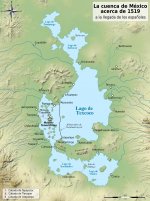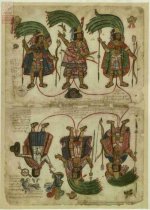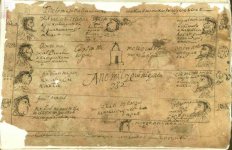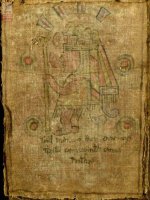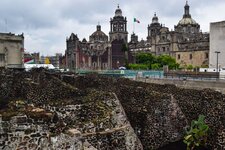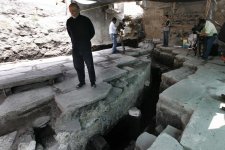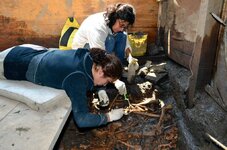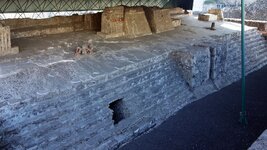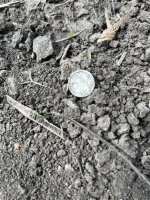Tador, the Mormons (LDS) believe the lost tribe of Israel migrated to Mexico, and essentially became the Aztecs, unless I am messing it up. It is described in the Book of Mormon, which is apparently an item of faith to those of that religion.
You are using an out of date browser. It may not display this or other websites correctly.
You should upgrade or use an alternative browser.
You should upgrade or use an alternative browser.
Location of Aztec Gold
- Thread starter Salvor6
- Start date
- Jun 27, 2004
- 504
- 891
Tador, the Mormons (LDS) believe the lost tribe of Israel migrated to Mexico, and essentially became the Aztecs, unless I am messing it up. It is described in the Book of Mormon, which is apparently an item of faith to those of that religion.
Your details are a bit rough...they don't beleive it was any of the lost tribes but a specific family and a few others that came here. That they became the Aztec is also a bit oversimplified but the case could be made. Ultimately they beleived two factions emerged from four brothers, over the space of centuries one of the groups was eliminated by the others.
cactusjumper
Gold Member
Your details are a bit rough...they don't beleive it was any of the lost tribes but a specific family and a few others that came here. That they became the Aztec is also a bit oversimplified but the case could be made. Ultimately they beleived two factions emerged from four brothers, over the space of centuries one of the groups was eliminated by the others.
Randy,
I don't believe the Mormon leaders will ever take an official position on that story. If you should run across such a person, give him my contact information.
Hope all is well with you and your family.
Take care,
Joe
- Jun 27, 2004
- 504
- 891
Randy,
I don't believe the Mormon leaders will ever take an official position on that story. If you should run across such a person, give him my contact information.
Hope all is well with you and your family.
Take care,
Joe
Joe, I'd disagree but this isn't the forum (literally) for it. Me and the famiyl are great and I'm hoping this year will be a great one. Submitted my first article to Lost Treasure, hoping a publication there will give me the momentum to publish a few more things. I've also had a good year with reading and finally managed to get my hands on a few obscure treasure titles. I've been building up my NPG collection, though I'm flumoxed right now to fill some holes. Feel free to PM me if you'd like to hash out some of the finer points of LDS historical sensibilities.

Incidentally, I hope you and your family are well also. You need to come over to Facebook, lots to see and do there.
Randy
Singlestack Wonder
Bronze Member
- Mar 28, 2014
- 1,711
- 2,627
- Detector(s) used
- Garrett AT Pro
- Primary Interest:
- All Treasure Hunting
According to the description of the next "The Curse of Oak Island" episode, the Aztec gold ended up at Oak Island. 

patiodadio
Hero Member
- Feb 28, 2014
- 578
- 592
- Detector(s) used
-
Whites 4000D
Garrett ATPro
- Primary Interest:
- All Treasure Hunting
How many different treasures are there on Oak Island ? It would be cool if it was Aztec gold there tho .......
adtofca
Banned
- Jan 22, 2016
- 88
- 102
- Detector(s) used
- minelab thingy
- Primary Interest:
- All Treasure Hunting
The trail is marked from Mexico City up to the Rio Grande and passed El Paso Texas and then the trail markers stop . has anyone tried to look
around the area where the trail markers stop ? I know about some men who did look around there in 1950 but they died and never found the treasure
around the area where the trail markers stop ? I know about some men who did look around there in 1950 but they died and never found the treasure
adtofca
Banned
- Jan 22, 2016
- 88
- 102
- Detector(s) used
- minelab thingy
- Primary Interest:
- All Treasure Hunting
I think they found some pottery and some stone carving but no treasure . I don't think they found any more marks though .
AnonymousExplorer
Tenderfoot
- Dec 25, 2016
- 8
- 7
- Primary Interest:
- All Treasure Hunting
Have you ever taken a look at the Utes origin story? Whats unique among the Utes is that they do not have a migration story - an anomaly among tribes. They are of Nahuatl origin and have two mass migrations headed to the South West following the sun. The origin of where they started is Tabakaiv or sun mountain, known today as Pikes Peak. The mountain is the literal manifestation of of the creator god, and the stairway to heaven - the very representation of Mexican pyramids. Other Nahuatl groups have migration stories for the most part described briefly from one world to the next. The Ute stories of the Flood and later the first snows that cause the first mass migration have a lot more detail. Afterwards the stories are picked up and are added by other tribes further SW. The origins of the Mexicans is vague before they lived in Aztlán. If we are going by native oral traditions and attempting to make connections, I would say one possibility would be on or nearby Pikes Peak for the location of the treasure. If the stories are correct, then Pikes Peak is the origin and the face of god for the Mexicans. I realize this is a presumptuous connection, but with the given data that is provided, many hypothesis are just that - taking leaps and making guesses. This area for the Utes also has brought forth a story of how Pikes Peak became full of riches of precious stone and gold - perhaps another origin of where the gold may have come from. Upon further study, we find that Pikes Peak, especially the eastern slope, so popular for hikers, has had no investigation for archeological sites. Most of the gold rush for the region was done on the SW side by Cripple Creek and if an ancient mine were to be found today on its slopes, it would probably be assumed as a mine created during the gold rush. Whats of further intrigue is that the first town, now called Old Colorado City, part of Colorado Springs, was originally supposed to be called El Dorado, and today, one of the rocks at Garden of the Gods is known as Montezuma's Tower. If Pikes Peak is indeed the birthplace of the Nahuatl peoples...where the protection of the mountain and its powers is repeated over and over again in different forms before the people departed for good. Then what better place to leave your sacred treasure than at the feet or on the very mountain of creation - under your gods watchful eye.
This is not enforced by archeology, but by oral native histories alone.
This is not enforced by archeology, but by oral native histories alone.
Interesting story. i know various scientists have claimed Aztec pottery and art styles relate to places in Utah.
Not knowing much beyond my back yard, I don't have any opinion here except to remind that the Emperor was never known as Montezuma to the indigenous people themselves. That was something the Europeans came up with, since they couldn't pronounce Nahuatl words. (You should hear my wife laugh at me for repeated attempts to pronounce the word Nahuatl in that language. I can't do it, period.)
I don't have any opinion here except to remind that the Emperor was never known as Montezuma to the indigenous people themselves. That was something the Europeans came up with, since they couldn't pronounce Nahuatl words. (You should hear my wife laugh at me for repeated attempts to pronounce the word Nahuatl in that language. I can't do it, period.)
So, my personal belief is any place or event called Montezuma is not ancient, but post-conquistador. You can believe whatever you wish, of course.
Not knowing much beyond my back yard,
 I don't have any opinion here except to remind that the Emperor was never known as Montezuma to the indigenous people themselves. That was something the Europeans came up with, since they couldn't pronounce Nahuatl words. (You should hear my wife laugh at me for repeated attempts to pronounce the word Nahuatl in that language. I can't do it, period.)
I don't have any opinion here except to remind that the Emperor was never known as Montezuma to the indigenous people themselves. That was something the Europeans came up with, since they couldn't pronounce Nahuatl words. (You should hear my wife laugh at me for repeated attempts to pronounce the word Nahuatl in that language. I can't do it, period.)So, my personal belief is any place or event called Montezuma is not ancient, but post-conquistador. You can believe whatever you wish, of course.
- Jun 27, 2004
- 504
- 891
Interesting story. i know various scientists have claimed Aztec pottery and art styles relate to places in Utah.
Not knowing much beyond my back yard,I don't have any opinion here except to remind that the Emperor was never known as Montezuma to the indigenous people themselves. That was something the Europeans came up with, since they couldn't pronounce Nahuatl words. (You should hear my wife laugh at me for repeated attempts to pronounce the word Nahuatl in that language. I can't do it, period.)
So, my personal belief is any place or event called Montezuma is not ancient, but post-conquistador. You can believe whatever you wish, of course.
You're probably onto something here piegrande, I too have felt the same about modern place names. You see a proliferation of names like Montezuma and Aztec in Southern Colorado, Northern Arizona and New Mexico as well as Southern Utah. Not surprisingly, if you research place names, most of these sites are also home to significant Pueblo and Anasazi ruins. Montezuma's Castle is a perfect example. Old Spanish maps often attribute these ruins to the Aztecs as well so it would seem many of these places were misattributed by the Spanish and later carried into the place-names as the United States were codified.
it is worth noting, however, that some of the South Western indigenous people's worshiped a deity named Montezuma as well, which may be a mixing of tribal legends with emerging Spanish influence. Either way it truly muddies the water when trying to get to the bottom of things related to Montezuma and the Aztec in the region.
South Sea mariner
Sr. Member
Hello All
The following newspaper story dating back to 1890 may be of interest.
The following 1890 newspaper account dated 4 January 1890 Rockhampton press.
Mexico to search for lost treasure which is believed to have been concealed near tho city of Mexico by the Emperor Guaulitimotzin, nephew of tho Emperor Montezuma II, when tho country fell into tho hands of Cortez and his companions 870 years ago. It is claimed that tho bullion which was thus hidden is worth at least sixteen millions sterling. This vast wealth is not in cash, but in gold-dust, gold ornaments, And gold utensils, diamonds, rubies, pearls, sapphires, and other precious stones
innumerable, tributes from thousands of subjects to their Sovereigns, spoils of war from conquered provinces rich in precious metals and rare jewels. It is believed to lie in vaults beneath tho Aztec ruins at Coyoacan, thirteen miles from the city of Mexico,and it is there that the search is going on.
The heir to the treasure .
Tho heir to this problematical wealth is Senior Nilario Camarcho y Torres, a dentist 85 years of age, who lives in tho city of Mexico, and claims to be the descendant and representative of the Montozumas. He bases his belief in the existence of tho treasure upon documents which have been jealously preserved in the family in more complete descriptions as to its position, and also what it was it consisted of, having been added during each generation. There cannot, he claims, be the slightest possible doubt as. to their authenticity and entire reliability. Their genuineness is not now and never has been disputed, so he told a recent interviewer.
A real cryptogram.
Senor Camarcho made no difficulty about exhibiting to his interlocutor the documents upon which his belief in the existence of where the treasure rests. Picking up the oldest-looking document, he spread it out in full view. It was a sheet of Mexican papyrus, made from the maguey-plant; about a foot square. It was yellow with age. It contained only the following inscription : — Guauhtemotzin, 1520. Coyoacnn, Uesto.
The remainder of the sheet was taken up by signs and hieroglyphics. Near the upper right hand corner were five small squares evidently meant to represent boxes, and three figures apparently intended for jugs or vases. Below these were much larger squares clearly indicating apartments. Near tho top of the picture and further to the left of tho signs indicating small squares and vases,was a circular mark intended to show the entrance to a subterranean passage.
Still further to the left and near the edge of tho shoot were signs representing tho points of tho compass ; the symbol of a rabbit indicated the south, a cactus-plant tho east, a bull rampant tho north ;and a symbol on, one side of which is missing, with the word " Uesto," 'showed where the west lay.
The story of The treasure
Picking up a second piece of papyrus containing words written in tho Aztec language, Senor Camarcho said "This is a -key or explanation To the former document, which' was made by tho Emperor Cuauhtemotzin, nephew of Montezuma, who succeeded to the throne when tho latter was imprisoned, by Cortez, and who recovered-' the treasures which Cortez had previously taken from Montezuma; when the Aztec's under command of Cuauhtemotzin, recaptured tho city of Mexico, from Cortex on July 12,: 1520. -Tho treasures were taken to tho palace of Montezuma at Coyoacan and buried deep in the earth.
The plan which I have previously shown you was the one made by the emperor Cuauhtemotzin and placed in 'concealment by him. No additional explanation was prepared for four that it might fall into tho hands of the Spaniards and giving them to discover the treasure. Before his deal , in 1520, the Emporor Cuauhtemotzin gave to his son, Dieago do Mendoza do Austria Montezuma Torres, a verbal explanation as to what the treasures located and consisted of and exactly where they had
been buried in the palace.
Tho son. afterwards committed this information In om paper which you hold in your, baud. It is written in Aztec, and sots forth that in the main room or salon of tho palace and in two adjoining rooms are buried, among other minor articles
of gold, and largo gold jar, containing diamonds, rubies, emeralds, sapphires, and other precious stones ; boxes containing gold collars formerly worn by princes and caciques, and ornamented with diamonds and large pearls ; large gold sacrificial cups, used by the priests when. victims were sacrificed to the gods and of golden sandals, with beads of gold, which were wrapped around the calves of the legs to keep the sandals on the feet, the bands being speckled with diamonds and rubies ; tho official golden collar sot with diamonds and emeralds; which was the property of tho Emperor Chachuilt ;
Golden crowns worn by tho Montozumas and others captured in war; from neighboring princes. Tho largest part of the treasure, however, is in gold-dust. Tho son dying in 1604,left the he precious paper to Barlolonie Moetozuma, who in turn bequeathed it to his descendants, our family's ancestors, and in due time it came into my possession."
The search
The excavations were stated some weeks ago, and Senor Camarcho expects to be in possession of his heritage by the second of-. November. Shortly after work was began tho bodies of eleven Aztecs were found in tho chief room of tho
buried palaces of the Montezuma.They were buried in irregular order, with their faces towards tho west. Tho remains were those of largo robust men, who in life must have stood nearly (5ft)Their physique had obviously been much superior to that of the stunted Indians who inhabit; Mexico at tho present day.
Tho bones were fibrous and very light, but little was left of the bodies. The remains were removed to tho National Museum in tho city of Mexico. the discovery of those bodies has caused the room in which they were found to be called.! tho "Hall of tho Dead."rather anything bettor than skeletons will be found we might find out in a months time.
It should be noted that the name of the last Aztec emperor was spelt various ways Cuauhtemotzin, Guatimozin or Guatemoc
Mal
The following newspaper story dating back to 1890 may be of interest.
The following 1890 newspaper account dated 4 January 1890 Rockhampton press.
Mexico to search for lost treasure which is believed to have been concealed near tho city of Mexico by the Emperor Guaulitimotzin, nephew of tho Emperor Montezuma II, when tho country fell into tho hands of Cortez and his companions 870 years ago. It is claimed that tho bullion which was thus hidden is worth at least sixteen millions sterling. This vast wealth is not in cash, but in gold-dust, gold ornaments, And gold utensils, diamonds, rubies, pearls, sapphires, and other precious stones
innumerable, tributes from thousands of subjects to their Sovereigns, spoils of war from conquered provinces rich in precious metals and rare jewels. It is believed to lie in vaults beneath tho Aztec ruins at Coyoacan, thirteen miles from the city of Mexico,and it is there that the search is going on.
The heir to the treasure .
Tho heir to this problematical wealth is Senior Nilario Camarcho y Torres, a dentist 85 years of age, who lives in tho city of Mexico, and claims to be the descendant and representative of the Montozumas. He bases his belief in the existence of tho treasure upon documents which have been jealously preserved in the family in more complete descriptions as to its position, and also what it was it consisted of, having been added during each generation. There cannot, he claims, be the slightest possible doubt as. to their authenticity and entire reliability. Their genuineness is not now and never has been disputed, so he told a recent interviewer.
A real cryptogram.
Senor Camarcho made no difficulty about exhibiting to his interlocutor the documents upon which his belief in the existence of where the treasure rests. Picking up the oldest-looking document, he spread it out in full view. It was a sheet of Mexican papyrus, made from the maguey-plant; about a foot square. It was yellow with age. It contained only the following inscription : — Guauhtemotzin, 1520. Coyoacnn, Uesto.
The remainder of the sheet was taken up by signs and hieroglyphics. Near the upper right hand corner were five small squares evidently meant to represent boxes, and three figures apparently intended for jugs or vases. Below these were much larger squares clearly indicating apartments. Near tho top of the picture and further to the left of tho signs indicating small squares and vases,was a circular mark intended to show the entrance to a subterranean passage.
Still further to the left and near the edge of tho shoot were signs representing tho points of tho compass ; the symbol of a rabbit indicated the south, a cactus-plant tho east, a bull rampant tho north ;and a symbol on, one side of which is missing, with the word " Uesto," 'showed where the west lay.
The story of The treasure
Picking up a second piece of papyrus containing words written in tho Aztec language, Senor Camarcho said "This is a -key or explanation To the former document, which' was made by tho Emperor Cuauhtemotzin, nephew of Montezuma, who succeeded to the throne when tho latter was imprisoned, by Cortez, and who recovered-' the treasures which Cortez had previously taken from Montezuma; when the Aztec's under command of Cuauhtemotzin, recaptured tho city of Mexico, from Cortex on July 12,: 1520. -Tho treasures were taken to tho palace of Montezuma at Coyoacan and buried deep in the earth.
The plan which I have previously shown you was the one made by the emperor Cuauhtemotzin and placed in 'concealment by him. No additional explanation was prepared for four that it might fall into tho hands of the Spaniards and giving them to discover the treasure. Before his deal , in 1520, the Emporor Cuauhtemotzin gave to his son, Dieago do Mendoza do Austria Montezuma Torres, a verbal explanation as to what the treasures located and consisted of and exactly where they had
been buried in the palace.
Tho son. afterwards committed this information In om paper which you hold in your, baud. It is written in Aztec, and sots forth that in the main room or salon of tho palace and in two adjoining rooms are buried, among other minor articles
of gold, and largo gold jar, containing diamonds, rubies, emeralds, sapphires, and other precious stones ; boxes containing gold collars formerly worn by princes and caciques, and ornamented with diamonds and large pearls ; large gold sacrificial cups, used by the priests when. victims were sacrificed to the gods and of golden sandals, with beads of gold, which were wrapped around the calves of the legs to keep the sandals on the feet, the bands being speckled with diamonds and rubies ; tho official golden collar sot with diamonds and emeralds; which was the property of tho Emperor Chachuilt ;
Golden crowns worn by tho Montozumas and others captured in war; from neighboring princes. Tho largest part of the treasure, however, is in gold-dust. Tho son dying in 1604,left the he precious paper to Barlolonie Moetozuma, who in turn bequeathed it to his descendants, our family's ancestors, and in due time it came into my possession."
The search
The excavations were stated some weeks ago, and Senor Camarcho expects to be in possession of his heritage by the second of-. November. Shortly after work was began tho bodies of eleven Aztecs were found in tho chief room of tho
buried palaces of the Montezuma.They were buried in irregular order, with their faces towards tho west. Tho remains were those of largo robust men, who in life must have stood nearly (5ft)Their physique had obviously been much superior to that of the stunted Indians who inhabit; Mexico at tho present day.
Tho bones were fibrous and very light, but little was left of the bodies. The remains were removed to tho National Museum in tho city of Mexico. the discovery of those bodies has caused the room in which they were found to be called.! tho "Hall of tho Dead."rather anything bettor than skeletons will be found we might find out in a months time.
It should be noted that the name of the last Aztec emperor was spelt various ways Cuauhtemotzin, Guatimozin or Guatemoc
Mal
Last edited:
South Sea mariner
Sr. Member
South Sea mariner
Sr. Member
South Sea mariner
Sr. Member
Another thing today if there was any treasure actually left its most likely buried under urban sprawl of Mexico city. determining the actual location even with a an ancient map would now be almost impossible as all relevant landmarks have been obliterated by 21st century Mexico city.
The question remain did they some thing more than 11 skeletons most likely one of them was the last Aztec emperor in 1890?
Regardless the story is fascinating.... pretty most of Piegrande comments are pretty much on the dime so to speak. As for treasure hidden in the American southwest it was perhaps connected to other local cultures in the south West deities loosely associated with the Aztec culture thus confusing the origin of the alleged treasure.
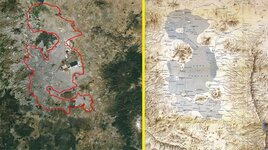
Mal
The question remain did they some thing more than 11 skeletons most likely one of them was the last Aztec emperor in 1890?
Regardless the story is fascinating.... pretty most of Piegrande comments are pretty much on the dime so to speak. As for treasure hidden in the American southwest it was perhaps connected to other local cultures in the south West deities loosely associated with the Aztec culture thus confusing the origin of the alleged treasure.

Mal
South Sea mariner
Sr. Member
One thing it did force me out of interest to discover a wonderful heritage in American south west of various groups of people in the beginnings of city state development. Its seems prevailing drought weather conditions and sporadic warfare between nomadic tribal groups hindered the development of large city state like the Aztec however their attempts of civilization is much to be admire especially mesa Verde among other sites. No doubt hidden out their still could be significant heritage sites. it does not take much leap of faith to imagine when the first Spanish explorers first saw these site they helped foster the Cibola story.
The Seven Cities of Gold is a myth that led to several expeditions by adventurers such as conquistadors in the 16th century.Perhaps partially true with gold added to attract interest in financial backers for a exploratory expedition? Yet there are it appear several small city states in the American south west and far north as Colorado and Utah.
Mesa Verde for men has to be one of top ten for amazing ruins around the world.
If I ever get to visit that part of the world one day it on my bucket list to visit....
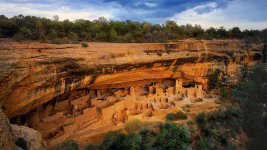
Mal
The Seven Cities of Gold is a myth that led to several expeditions by adventurers such as conquistadors in the 16th century.Perhaps partially true with gold added to attract interest in financial backers for a exploratory expedition? Yet there are it appear several small city states in the American south west and far north as Colorado and Utah.
Mesa Verde for men has to be one of top ten for amazing ruins around the world.
If I ever get to visit that part of the world one day it on my bucket list to visit....

Mal
South Sea mariner
Sr. Member
South Sea mariner
Sr. Member
But what about Aztec treasure what did it really look like.
here is the only picture I could find that appears to be actual Aztec treasure as most gold working was done by other cultures in region.
This picture BELOW is from the National Museum of Mexico.
View attachment 1396065
Happy new year Mal
here is the only picture I could find that appears to be actual Aztec treasure as most gold working was done by other cultures in region.
This picture BELOW is from the National Museum of Mexico.
View attachment 1396065
Happy new year Mal
Top Member Reactions
-
 2153
2153 -
 1031
1031 -
 988
988 -
 925
925 -
 849
849 -
 798
798 -
 782
782 -
 705
705 -
 573
573 -
 545
545 -
 472
472 -
 461
461 -
O
457
-
 429
429 -
 427
427 -
 421
421 -
 417
417 -
 405
405 -
 371
371 -
 368
368
Users who are viewing this thread
Total: 3 (members: 0, guests: 3)



